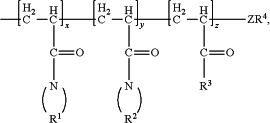| CPC C08F 226/08 (2013.01) [C08F 220/06 (2013.01); C09K 8/54 (2013.01)] | 6 Claims |
|
1. A method for inhibiting corrosion, the method comprising:
contacting a metal with at least one polymer of the general formula:
 wherein R1 are and R2 are each independently divalent C4-C7 aliphatic groups or divalent C4-C7 heteroaliphatic groups, optionally substituted with one or more C1-C6 aliphatic groups, heteroatoms independently chosen from S, N, and O, or combination thereof, wherein the divalent C4-C7 heteroaliphatic groups of R1 and R2 comprise one or two heteroatoms independently selected from the group consisting of S, N, and O, and the maximum number of heteroatoms in R1 or R2 is two;
R3 is selected from the group consisting of —OH, NH2, —OCH3, —OCH2—CH3, —NH—CH2—CH3, monovalent C4-C7 aliphatic groups and monovalent C4-C7 heteroaliphatic groups, optionally substituted with one or more C1-C6 aliphatic groups, heteroatoms independently selected from the group consisting of S, N, and O, or combinations thereof, wherein the monovalent C4-C7 heteroaliphatic groups of R3 comprise one or two heteroatoms independently selected from the group consisting of S, N, and O, and the maximum number of heteroatoms in R3 is two;
Z is a heteroatom selected the group consisting of S, N, O, and R4;
R4 are each independently selected from the group consisting of —H, —CH2—COOH, —CH2—CH2—NH2, —CH2—CH2—NH3+Cl−, —CH2—CH2—OH, —CH2—CH2—CH3, and CH3;
x is a molar fraction range chosen from 0.1 to 0.9;
y is a molar fraction range chosen from 0.1 to 0.9; and
z is a molar fraction range chosen from 0 to 0.8, wherein the summation of x, y, and z equals 1.
|